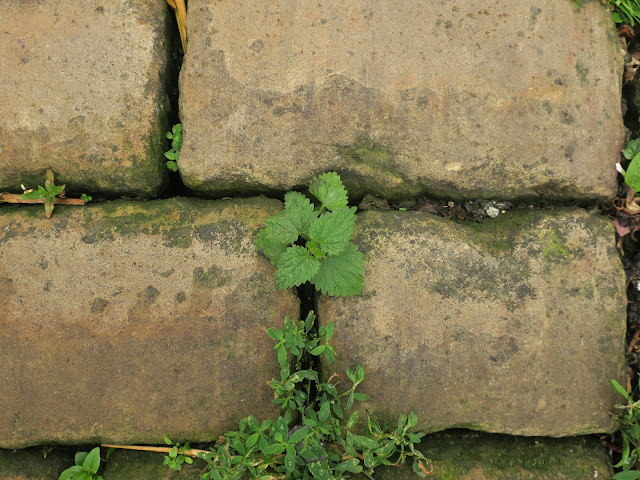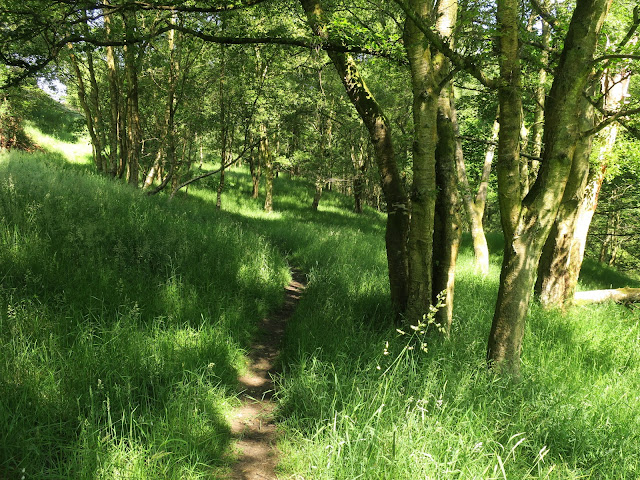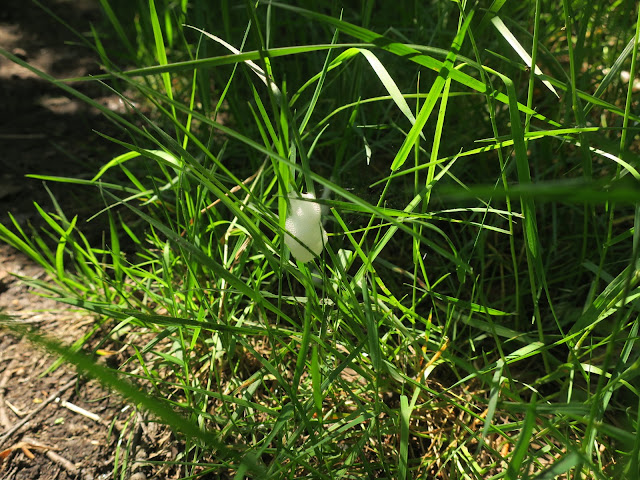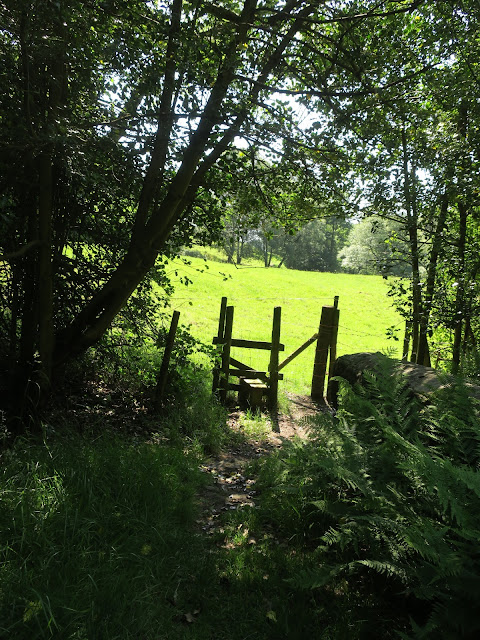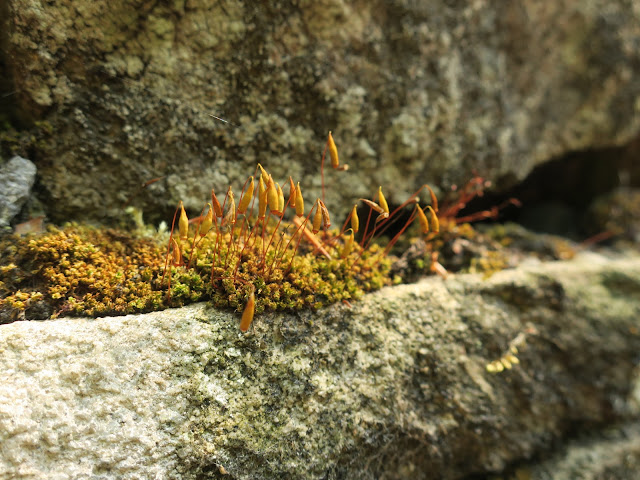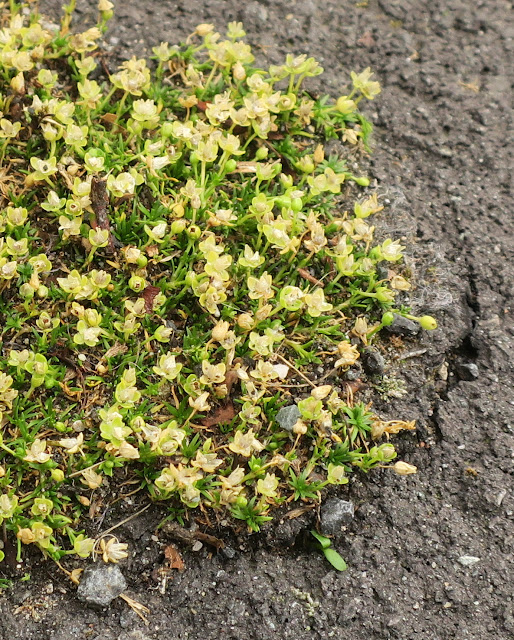Although
Loose and Leafy is predominantly about plants and insects I'm used to doing my own thing and over these last few days I've found I've been wandering around (in so far as I can wander!) photographing walls. One can stretch a theme so far but I don't think a wall can be counted in itself as 'wild'. So I scanned the info. to see where I could squeeze 'walls' into the project and found that one of the squares on the nature table is 'Moss and Mud'. I do have some photos of mud but I'm not in a 'mud' sort of mood today. All this sudden fresh air and exercise is making me a bit peevish and
very tired. I keep telling myself it's good for me and that strength will properly return but it's a bit of a slog.
As an aside - I was enlivened somewhat today by hearing a cuckoo. I haven't heard a cuckoo for years. I can give myself a tick for this; 'Listen out for birdsong and learn who it's coming from' is on one of the squares on the 30 days 'passport'. (Squares figure large in this challenge, there's even a 'bingo' card - more squares.
However, today I walked past this stone building which is gradually being overcome by moss; I'll put this building with its moss then on the virtual nature table. There are lots of stone buildings being destroyed by nature around here but this one looks as if its managing to hold its own despite the onslaught. Roots are the real demolition gang and mosses don't have any - just things called 'rhyzoids' which help them stick to whatever they are sitting on.
Looking at walls though will, also, almost inevitably, bring one face to face with lichen. Lichen is even weirder than moss, being not one organism but a conglomeration. I knew lichen is fungi and algae together but when I was looking it up I found there's another thing involved - cyanobacteria. Until today I'd not heard of cyanobacteria. Should I try to learn about them? understand them? interest you in them? explain them?
"Cyanobacteria /saɪˌænoʊbækˈtɪəriə/, also known as Cyanophyta, are a phylum consisting of free-living photosynthetic bacteria and the endosymbiotic plastids, a sister group to Gloeomargarita, that are present in some eukaryotes. They commonly obtain their energy through oxygenic photosynthesis."
I haven't the foggiest idea what any of this means so I'll leave it hanging. One of the basic tenets of Loose and Leafy is that it's possible to to appreciate things to a significant degree without necessarily knowing what they are. This is not to say that I would not benefit from knowing more. Rather it's a determination not to let lack of knowledge deter me from exploration. And in the presence of lichens, it's not only that I rarely know what kind of lichens I'm looking at, I find them so science-fictiony I'm almost frightened to think about them. This, of course, is contradictory but I expect you can cope.
Stepping sideways . . . When I lived in Dorset, I lived by the sea. The natural history interest of the seashore is never ending and even when I went inland, the sea was never far away, not really. And when I was walking by the sea, the green hills of inland Dorset were never far from me either. I wouldn't expect to find a jellyfish on a hilltop, obviously, or honeysuckle rambling over a rock that's submerged at high tide but, broadly speaking, there was an interconnectedness between the various sceneries.
Here in West Yorkshire, I am finding it very different. The hills are steep, the valleys deep. Within a few minutes I am walking between different worlds.

A few days ago, up on Warley Moor, I found masses of tiny butterflies rushing about my feet. None would stay still long enough to photograph and in all their brief pauses they shut their wings. There were tiny, tiny bumblebees as well. Ordinary daisies were a fraction of the size of the daisies I'm used to. And there was an odd heathery plant that had just four pink bells on the top - very understated. The whiteness of the Hare's Tail Cottongrass seedheads had receded and was almost completely gone now. There had been acres of it only a few days before. I'd been told (on
iSpot) that the difference between Common Cottongrass and Hare's Tail Cottongrass is that Hare's Tail Cottongrass has only one seedhead on a stem and Common Cottongrass more than one. Apparently the wind and the rain can fuse them so it might be easy to muddle which is which. Definitely these had only one head per stem. I picked one stem to photograph when I got home.
First, though, I wanted to
photograph a lichen I'd first met a year ago on the little stone bridge I showed you on
Day 8 so I gave the seedhead to my companion to look after. He put it in his hat. In his hat! Would you put delicate samples in your hat for safe-keeping? No. I didn't think so. They get squashed. Obviously. I'll need to wait almost a year for another chance. But that's good. Thinking ahead!
So . . . back to today, I began my walk lower down the hill. Not that it
feels as if it's down a hill. It
feels very high and windswept there. And, on a dry stone wall, were the fruiting bodies of another lichen. Very tiny. Very ethereal.
 |
| I think these are 'Pixie Cups' - (Cladonia pyxidata) |
There was more than one patch of it.
A difference in the landscape. Less mud than higher on the moor! There are few dwellings on the tops of the moors but lots of people live at this middle height so there are houses and farms, even if they aren't in the picture; and more discernible divisions between the fields.
But still there's further to go. Further down and down into Luddenden valley towards the stream (brook?) at the bottom. The mossy building is half way down the hill. Further round on roughly the same contour is a little stand of trees and yet another kind of lichen on a rock that's part of a fallen wall.
And, eventually reaching the bottom, in a place where it's warm and still and sheltered and green, on a branch across the stream is yet
another kind of lichen.
I don't know what any of them are!
What of the tiny butterflies? On the Butterfly Conservation Site where you can
get help with IDs, I ticked boxes for 'England', 'Small' 'Orange' and 'Grey'. Up came '
Small Heath'. That was what they looked like. That it seemed, was it! Except . . . it can be found in southern England and I am in the north of England. But the text also says it is widespread so may be that was ok. I read on.
"Occurs on grassland where there are fine grasses, especially in dry, well-drained situations where the sward is short and sparse. Typical habitats include; heathland, downland and coastal dunes, but it is also found on road verges, moorland and in woodland rides."
It wasn't feeling quite 'right'. This was not a '
dry, well-drained situation'. (See the photo of the sky reflected in the puddle above!) There are big yellow notices all over the place warning us to take care not to sink.
Despite it being a very small butterfly, I clicked for 'Large Heath'.
"The main foodplant is Hare's-tail Cottongrass (Eriophorum vaginatum)"
Bingo!
And . . .
"The butterflies breed in open, wet areas where the foodplant grows, this includes habitats such as; lowland raised bogs, upland blanket bogs and damp acidic moorland. Sites are usually below 500m (600m in the far north) and have a base of Sphagnum moss interspersed with the foodplant and abundant Cross-leaved Heath (the main adult nectar source)."
Another hurdle . . . what is 'Cross-leaved Heath'? I go to Google images and
Wikepedia (as one does) and . . . it's the tough little plant with the meagre display of pink flowers. So . . . my little butterfly is a Large Heath even though it's a little butterfly.
Very exciting. I've got three layers of habitat, the high moor, the middle and the valley. I've identified a butterfly, a heather (a heath is a heather) a sedge (Hare's Tail Cottongrass is a sedge) heard a cuckoo, inspected several lichens and admired a mossy stone shed.
 |
|
Today's Random Act of
Wildness is to
look at moss
and lichen,
listen to a bird,
identify a butterfly
and two plants.
|
Links:



